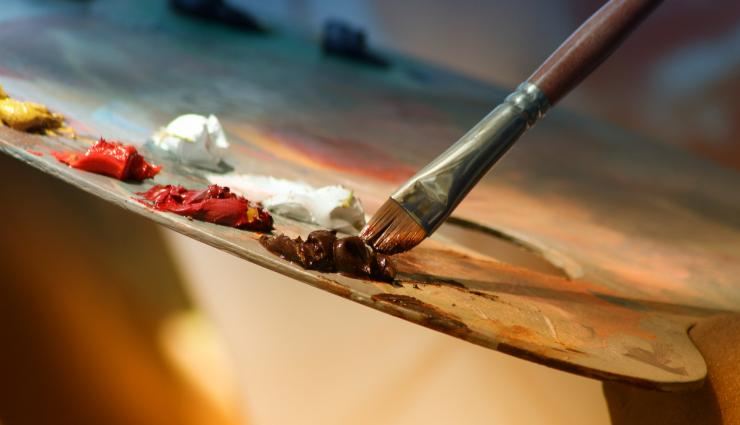Your cart is currently empty!

We’ve received a lot of feedback from our readers, and we’re thrilled that many of you have found our tips and exercises helpful in honing your oil painting skills. But we understand that some of you still feel like you’re not quite getting to the next level, despite your efforts. We’ve been there too — and it’s frustrating. But don’t worry, we’re here with a more comprehensive guide to help you break through those barriers and start seeing real progress.
In this blog post, we’ll explore how to structure your practice, incorporate the techniques of famous artists, and overcome common obstacles that even professionals face. Ready to take your skills to the next level? Let’s dive in.
🌟 1. Don’t Rush, Master the Basics First
It’s tempting to jump into painting full-fledged compositions or advanced techniques right away, but real improvement starts with mastering the basics. Some of the world’s greatest artists, like Leonardo da Vinci and Claude Monet, spent years perfecting their understanding of form, light, and color before creating their most iconic works.
What to Focus On:
- Shapes and Lines: Practice drawing straight lines, curves, and basic shapes. Many artists start with still life exercises to master the fundamentals.
- Shading and Texture: Understand how light interacts with objects and start practicing your shading techniques. Pay attention to how different textures, like wood, glass, or fabric, can be recreated with oil paints.
- Color Mixing: Don’t just rely on premade colors. Start mixing your own shades to understand how colors interact and influence the overall composition.
🌟 2. Take Inspiration from the Masters
One of the best ways to improve your painting is by learning from the greats. Vincent van Gogh was known for his famous brushstrokes, but did you know he spent years copying Old Masters’ works before developing his own unique style?
How to Apply This:
- Study Old Masterpieces: Try replicating parts of classic paintings. This exercise helps you understand the techniques and brushwork that made those pieces stand out.
- Experiment with Brushwork: Van Gogh’s thick, expressive strokes were key to his style. Try using impasto techniques (thick layers of paint) and experiment with texture to create a more expressive piece.
🌟 3. Consistency is Key — Make Practice a Habit
Remember, practice doesn’t make perfect — it makes permanent. Consistent practice is essential for long-term improvement. Even Pablo Picasso didn’t create his masterpieces overnight. He spent countless hours experimenting and refining his technique.
How to Build a Practice Routine:
- Set Small, Achievable Goals: Focus on one specific skill each week. For instance, dedicate one week to mastering color blending, then move on to understanding perspective the following week.
- Daily or Weekly Practice: Set aside time every day or a few times a week to paint. The more you practice, the better you’ll get — it’s simple, but effective.
🌟 4. Don’t Be Afraid to Fail (or Make Mistakes)
A common misconception is that all great artists were born with natural talent. But the truth is, failure is part of the process. Even Michelangelo made mistakes and had to learn through trial and error. The key is to embrace mistakes as opportunities to learn and improve.
How to View Mistakes as Learning Opportunities:
- Step Back and Reflect: If you feel stuck or frustrated, take a break and look at your work from a distance. Ask yourself what works and what doesn’t. Often, stepping away can give you a new perspective.
- Learn from Each Mistake: Every time you make a mistake, ask yourself what caused it. Did you mix the colors wrong? Did the composition feel off? These insights can help you avoid the same mistake in the future.
🌟 5. Experiment with Different Styles and Mediums
Sometimes, stepping outside of your comfort zone can lead to breakthroughs. Georgia O’Keeffe, a pioneer of American modernism, often experimented with both abstraction and realism. Her approach to oil painting was all about pushing boundaries and exploring new artistic expressions.
How to Experiment:
- Try New Techniques: Switch between glazing, scumbling, and wet-on-wet techniques to see which ones suit your style.
- Play with Different Subjects: Don’t limit yourself to one type of subject matter. Experiment with landscapes, portraits, or abstract designs.
- Use Different Brushes: Different brushes create different effects. Experiment with flat, round, and filbert brushes to understand how each one affects texture and composition.
🌟 6. Patience is a Virtue
Finally, remember that oil painting is a slow process. Unlike other mediums, oil paint takes time to dry and layer properly. Don’t rush your progress. Henri Matisse famously said, “Creativity takes courage.” Be patient with yourself and enjoy the journey.
💡 Conclusion
Improvement in oil painting doesn’t happen overnight, but with consistent practice, studying the masters, and embracing mistakes, you’ll start to see your skills grow. Just like Leonardo da Vinci, who spent decades learning before creating masterpieces, you too can master the craft of oil painting through steady dedication.